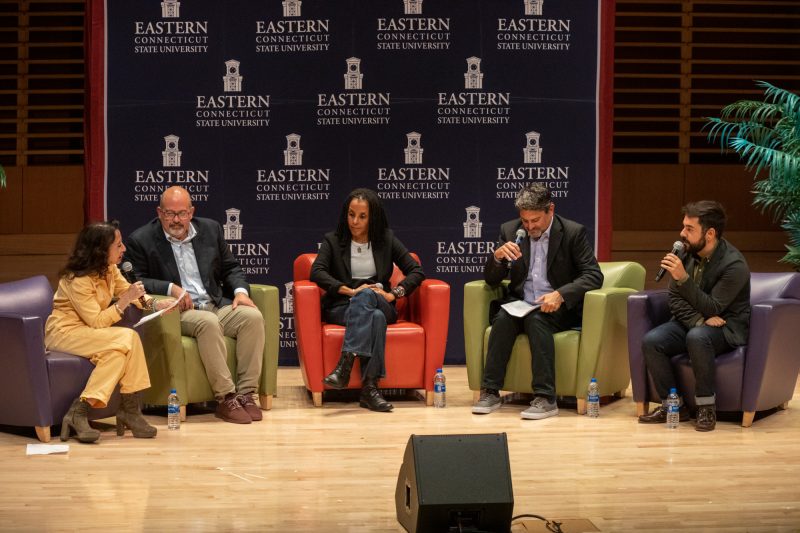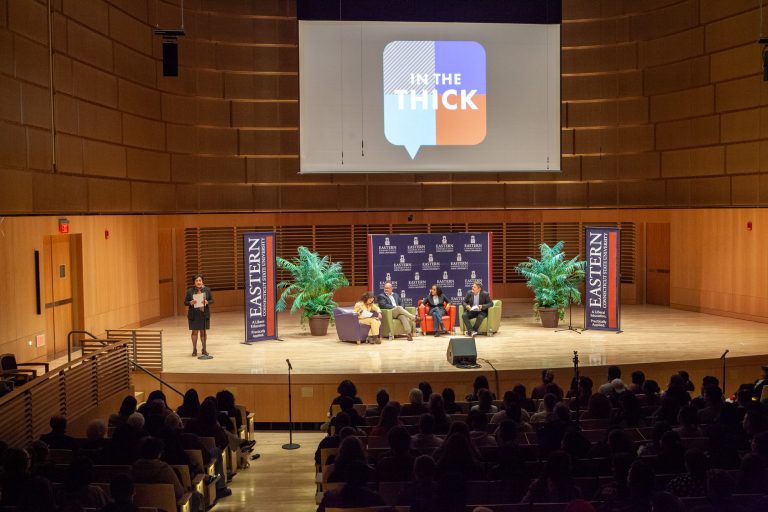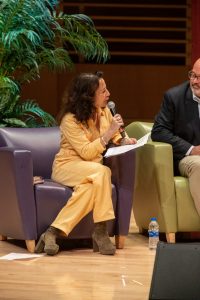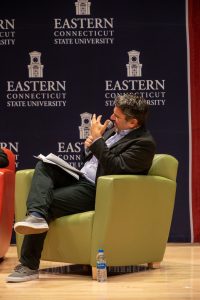


Published on October 24, 2019

Award-winning journalist Maria Hinojosa and her co-host Julio Ricardo Varela visited Eastern Connecticut State University on Oct. 22 to record a live show for their critically acclaimed podcast “In the Thick.” The podcast addressed issues within the Latino community in Connecticut, focusing on the current political climate around immigration.
Hinojosa began the podcast by debunking the myth that Connecticut residents are principally white and from the upper class. “Latinos make up about 16 percent of the state’s population and that figure is growing,” said Hinojosa. She added that while the Latino community in Connecticut is the 18th largest in the nation, Latinos at times feel invisible. According to the National Conference of State Legislatures, only seven percent of Latinos make up Connecticut’s General Assembly and no member of the state’s congressional delegation is Latino.
To comment more on the immigrant and Latino community in the state, Hinojosa invited attorney Kica Matos to speak. Matos is an immigrant rights and racial justice advocate and director of the Center on Immigration and Justice in Connecticut. “Do we feel invisible in Connecticut? In some parts we do,” said Matos, who has lived in Connecticut for 12 years. She recalled towns like Greenwich, where the Latino voice is not as visible as it is in other towns, such as Hartford, Bridgeport and New Haven.
“It seems like these immigrant and Latino communities have economically propped up these cities? Am I right?” asked Hinojosa, referring to Bridgeport, Hartford and New Haven. “You’re absolutely right,” responded Matos. She explained how immigrant communities that came to cities such as New Haven during the ‘70s and ‘80s helped reverse the damage caused by the crack epidemic.

Eastern President Elsa Núñez introduces panelists for live recording of podcast “In the Thick.”
“The immigrant population started coming in, and two decades later we have a really vibrant community of Latino/a immigrants who really dominate the neighborhood. The vibrancy and economic investments are really coming from immigrants.”
Professor Charles Venator-Santiago from the Department of Political Science at the University of Connecticut was another guest on the show. Santiago’s current research focuses on U.S. territorial citizenship and status law and policy. He has also written several books on Puerto Rico and on the criminal justice system.

“As of 2016, the state was ranked the sixth most popular, in terms of Puerto Rican population … and 10 percent of the 135,000 Puerto Ricans who have left Puerto Rico since Hurricane Maria moved to Connecticut. That is 13,500 people,” said co-host Varela.
Santiago elaborated on the reality that Puerto Ricans are going through an immigrant experience, despite being U.S citizens. “After Hurricane Maria, the Federal Emergency Management Agency (FEMA) decided to pull people from Puerto Rico and throw them into hotels and let them figure things out.” He further explained that only about half of Puerto Ricans who were initially moved to Connecticut ended up staying, others moved to other areas to be with friends and family members.
Matos also said the large shift in the Latino community in Connecticut impacts state politics. According to the most recent census, approximately 120,000 undocumented immigrants live in Connecticut. Unlike Puerto Ricans, they do not have the power to vote. “Their power is different because they can vote, unlike many of the other Latino populations in Connecticut,” said Matos.
She also explained how the political tensions in the country have made Puerto Ricans shift their mindset on how they see themselves in the country. “For a long time many Puerto Ricans, not all, distinguished themselves from a lot of other Latinx communities. They said, ‘well we are Puerto Ricans, we have U.S citizenship — we’re the bomb.’ There was an effort to distinguish themselves. Under this administration, what we’re seeing is a change, because the racism that is being unleashed is not just against undocumented immigrants. It is being unleashed on all Latinx communities.”

To provide perspective on how the Latinx and immigrant communities are taking action against the racism and hatred they are seeing toward such communities, Hinojosa and Varela invited Lucas Codognolla to speak. Codognolla, a 24-year-old undocumented activist who immigrated to the United States when he was 9 years old is currently the executive director of Connecticut Students for a Dream (C4D), a youth-led organization that fights for the educational and civil rights of undocumented students in Connecticut.
Codognolla shared his immigrant experience in Connecticut and the actions his organization is taking to support the rights of undocumented people in Connecticut. “We are in the business of politicizing young people of color to understand systems of oppression and understand how criminalization of communities of color work in terms of all of the intersectionalities.” He pointed out that while Connecticut has passed acts to benefit the immigrant community, if they are not implemented correctly, they cannot serve the community correctly.
The panelists further explored how immigrants are viewed in Connecticut and whether the immigrant community is truly embraced, as many of its members believe it is. The full podcast recorded at Eastern will be uploaded within the next few weeks. To listen to the live recording of the episode, visit http://inthethickshow.org/live-from-connecticut-immigration.
The event was made possible through joint funding from the Community Foundation of Eastern Connecticut and the William Caspar Graustein Memorial Fund. The grant was given to advance equity and youth civic engagement in our community and to provide a learning experience for students who wouldn’t otherwise have access to it. “The Community Foundation is deeply committed to empowering youth and addressing inequities in our region,” said Maryam Elahi, president and CEO of the Community Foundation of Eastern Connecticut. “We are proud to partner with the Graustein Memorial Fund and Eastern Connecticut State University to provide this exceptional opportunity for students to learn from Maria Hinojosa, one of the leading journalists in this country.”
Written by Vania Galicia